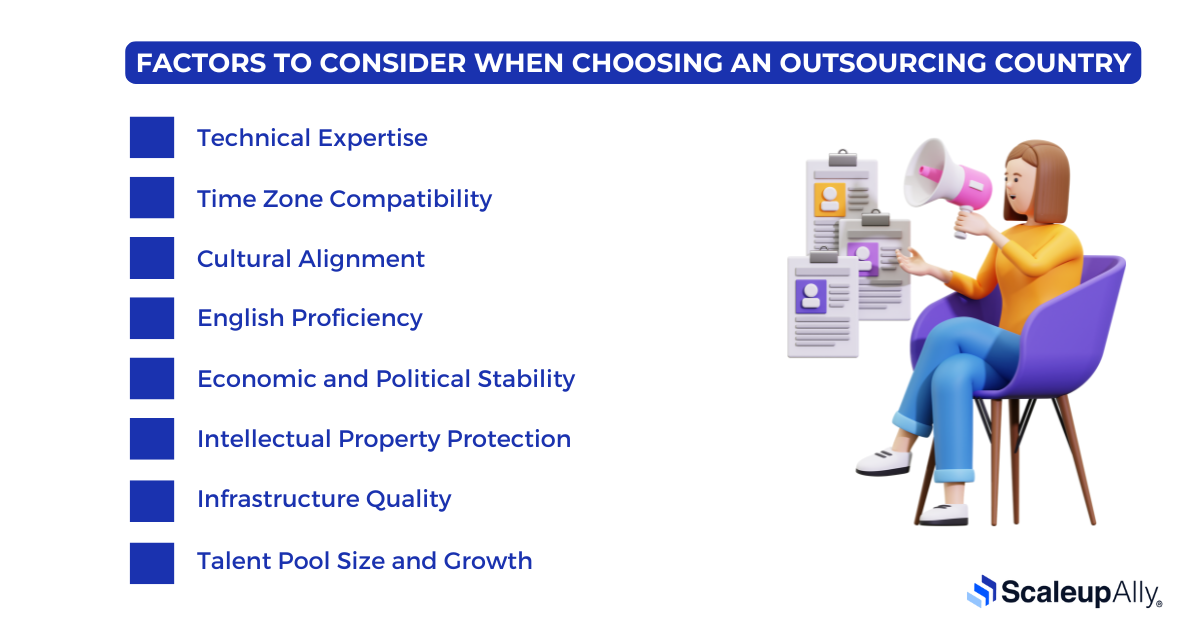
13 Best Countries to Outsource Software Development
Pranay Agrawal | April 1, 2025 , 17 min read
Table Of Content
In our line of work, we’ve had the opportunity to interact with companies that outsource software development. We’ve watched how some thrive and how others have crashed spectacularly. The difference between those who thrive and those who crash is rarely technical skills alone. This is a known occurrence. In fact, 70% of companies cite ‘better value beyond cost savings’, like cultural fit and communication, as a key factor in choosing an outsourcing partner.
The successful ones recognized that language proficiency, time zone compatibility, and business culture alignment often matter more than saving an extra percentage point on hourly rates.
For that matter, we have compiled this guide that examines the best countries to outsource software development, and what each country brings to the table. It doesn’t matter if you’re building your first MVP or scaling an enterprise solution; knowing these 13 outsourcing destinations might be the most valuable strategic advantage you’ll gain this year.
Key Takeaways
- Eastern European countries like Poland and Romania offer strong technical expertise with cultural alignment to Western business practices, though at higher rates than Asian alternatives.
- Southeast Asian nations (Philippines, Vietnam) would usually provide excellent value with competitive rates, although time zone differences and communication barriers may require some additional management.
- We advise that when outsourcing, you should consider the technical expertise of the country or company, their time zone compatibility, English proficiency, and IP protection before you commit. These factors significantly impact project success.
- The ideal outsourcing country varies by project. Smaller specialized teams might excel in Eastern Europe, while massive enterprise projects might leverage India’s scale and experience.
Top Countries for Outsourcing Software Development
Let’s explore the 13 best offshore software development countries with insights that will help you make informed outsourcing decisions for your software development needs.
1. India
India remains the best country in software development outsourcing, with the largest pool of developers globally. This is no surprise as it is projected by statstia that by 2029, the market volume of india is expected to reach $20.81 billion, showcasing significant expansion potential.
- Legal Safety: Moderate. Many established outsourcing companies have developed internal compliance programs to address Western concerns.
- English Proficiency: High. English is widely spoken in business contexts. However occasional challenges are accents and cultural communication differences.
- Average Hourly Rates:
-
- Junior Developer: $15-25
- Mid-level Developer: $25-40
- Senior Developer: $40-60
- Project Manager: $50-75
- Pros:
-
- Massive talent pool across numerous technologies
- Well-established outsourcing infrastructure and processes
- 24/7 support capabilities
- Experience handling large-scale enterprise projects
- Cons:
-
- Cultural differences in project management
2. Poland
Poland is among the best countries for outsourcing software development in Eastern Europe, with over 250,000 skilled developers.
- Legal Safety: High. EU membership provides intellectual property protection and data security governed by GDPR. The legal system is transparent and aligned with Western standards.
- English Proficiency: Very high. Poland ranks 16th globally in English proficiency with approximately 30% of the population speaking English fluently. Technical professionals typically demonstrate excellent communication skills.
- Average Hourly Rates:
-
- Junior Developer: $25-35
- Mid-level Developer: $35-60
- Senior Developer: $60-85
- Project Manager: $70-100
- Pros:
-
- A strong technical education system that produces over 17,000 IT graduates annually
- Cultural proximity to Western business practices
- Specialization in fintech, gaming, and enterprise software
- Convenient time zone for European clients (only 1-2 hours difference)
- Cons:
-
- Rising costs compared to other Eastern European options
- Potential resource constraints for very large projects
3. Ukraine
Ukraine produces around 16,000–17,000 IT graduates annually, supported by both formal education and corporate training programs. Despite ongoing challenges, Ukraine maintains its position among the best offshore software development countries with approximately 281,000 IT professionals.
- Legal Safety: Moderate. Companies typically operate through contracts with well-established legal frameworks, though the current geopolitical situation introduces some uncertainty.
- English Proficiency: Good and improving. About 85% of IT specialists have intermediate or higher English levels.
- Average Hourly Rates:
-
- Junior Developer: $25-35
- Mid-level Developer: $35-55
- Senior Developer: $55-80
- Project Manager: $60-90
- Pros:
-
- Strong mathematical and scientific education background
- Exceptional problem-solving skills with complex technical challenges
- Cultural affinity with European work styles
- Particular expertise in C++, Java, and data science
- Cons:
-
- Geopolitical instability affects long-term planning
- Power infrastructure challenges in some regions
- Higher rates than some Asian alternatives
- Potential visa complications for in-person meetings
4. Philippines
The Philippines has a thriving IT industry, with approximately 1.57 million professionals working in the IT-BPM (Business Process Management) sector, according to recent data. This number is expected to grow significantly, reaching around 2.5 million by 2028. The Philippines combines technical capabilities with outstanding service orientation.
- Legal Safety: Moderate to high. The legal system is based on American models with strong contractual enforcement, though intellectual property protections lag behind Western standards.
- English Proficiency: Excellent. The Philippines ranks 22nd globally in English proficiency, with natural American-accented English widely spoken.
- Average Hourly Rates:
-
- Junior Developer: $18-28
- Mid-level Developer: $28-45
- Senior Developer: $45-65
- Project Manager: $50-75
- Pros:
-
- Cultural alignment with Western business practices
- Exceptional customer service orientation
- Lower turnover rates than many competing markets
- Strong BPO infrastructure and experience
- Cons:
-
- A smaller pool of specialized developers compared to India
- Internet infrastructure challenges outside major cities
- Vulnerability to natural disasters
- Less experienced with cutting-edge technologies
5. Romania
Romania is home to over 202,000 software developers. This makes it one of the leading hubs for tech talent in Central and Eastern Europe, with cities like Bucharest, Cluj-Napoca, and Iași being key centers for software development.
- Legal Safety: High. EU membership provides strong contractual and intellectual property protections under familiar legal frameworks.
- English Proficiency: Very high, especially among technical professionals. Romania ranks 19th globally in English proficiency.
- Average Hourly Rates:
-
- Junior Developer: $25-40
- Mid-level Developer: $40-60
- Senior Developer: $60-90
- Project Manager: $65-95
- Pros:
-
- Outstanding technical education with a focus on mathematics and engineering
- Fast internet infrastructure (consistently among the world’s top 10)
- Excellent cybersecurity expertise
- Compatible time zone with European clients
- Cons:
-
- Smaller talent pool than some competitors
- Rising rates as demand increases
- EU regulations can increase compliance requirements
- Limited scalability for very large projects
6. Vietnam
Vietnam’s IT industry is thriving, with approximately 1.2 million IT professionals.
- Legal Safety: Moderate. While legal frameworks are improving, contracts should be carefully structured with trusted partners.
- English Proficiency: Moderate but improving at a fast pace. Technical documentation typically requires more review than with other countries.
- Average Hourly Rates:
-
- Junior Developer: $15-25
- Mid-level Developer: $25-40
- Senior Developer: $40-60
- Project Manager: $45-70
- Pros
-
- Young, technically proficient workforce
- Strong government investment in technical education
- Significantly lower costs than many alternatives
- Growing expertise in mobile development
- Cons:
-
- Communication challenges may require more management oversight
- Less experience with enterprise-scale projects
- Cultural differences in problem-solving
- Time zone challenges with Western clients
7. Argentina
Argentina offers a distinctive Latin American alternative with approximately 115,000 software professionals.
- Legal Safety: Moderate. Contract enforcement is generally reliable, though economic volatility can impact long-term arrangements.
- English Proficiency: Good, especially among technology professionals. Argentina ranks highest in English proficiency in Latin America.
- Average Hourly Rates:
-
- Junior Developer: $30-45
- Mid-level Developer: $45-65
- Senior Developer: $65-90
- Project Manager: $70-100
- Pros:
-
- Time zone compatibility with North American clients
- Cultural similarity to Western business practices
- Strong creative problem-solving capabilities
- Excellent design-oriented development
- Cons:
-
- Economic instability can affect pricing and retention
- Higher rates than Asian and some Eastern European options
- A smaller specialized talent pool
- Political transitions can impact business climate
8. Mexico
With 700,000+ IT professionals, Mexico combines proximity to the US with significant technical capabilities.
- Legal Safety: Moderate to high. NAFTA/USMCA provides solid intellectual property protections and familiar legal frameworks for American companies.
- English Proficiency: Variable. Major tech hubs like Guadalajara and Mexico City have good English levels, though not as consistent as some European options.
- Average Hourly Rates:
-
- Junior Developer: $25-40
- Mid-level Developer: $40-60
- Senior Developer: $60-85
- Project Manager: $65-95
- Pros:
-
- Minimal time zone differences with US clients
- Possibility for easy in-person collaboration
- Cultural familiarity with American business practices
- Strong expertise in web and mobile development
- Cons:
-
- Higher rates than many Asian alternatives
- Security concerns in certain regions
- Uneven quality between providers
- Less experience with cutting-edge technologies
9. China
China’s massive tech sector includes over 7 million software professionals, though only a portion of them work in outsourcing.
- Legal Safety: Moderate. Intellectual property concerns remain significant despite improvements. Working with established firms with international experience is essential.
- English Proficiency: Limited outside major international firms. Projects typically require more management oversight and clear documentation.
- Average Hourly Rates:
-
- Junior Developer: $20-35
- Mid-level Developer: $35-55
- Senior Developer: $55-80
- Project Manager: $60-90
- Pros:
-
- Enormous talent pool, especially in emerging technologies
- Strong expertise in AI, machine learning, and mobile development
- Advanced technical infrastructure
- Experience with large-scale systems
- Cons:
-
- Communication challenges require additional management
- Cultural differences in project and problem-solving
- Intellectual property concerns
- Political and regulatory complications
10. Bulgaria
Bulgaria has approximately 72,000 IT professionals, making up about 1.05% of its population. This makes it one of the sought-after software outsourcing destinations in Eastern Europe.
- Legal Safety: High. EU membership provides strong intellectual property and contractual protections under familiar legal frameworks.
- English Proficiency: Very good, especially among younger technical professionals.
- Average Hourly Rates:
-
- Junior Developer: $25-35
- Mid-level Developer: $35-55
- Senior Developer: $55-75
- Project Manager: $60-85
- Pros:
-
- Excellent price-to-quality ratio compared to other EU nations
- Strong mathematical and engineering education
- Compatible time zone with European clients
- Emerging expertise in blockchain and fintech
- Cons:
-
- Smaller talent pool limits scalability
- Retention challenges as Western companies establish local offices
- Less name recognition than major outsourcing destinations
- Limited experience with certain specialized technologies
11. Brazil
Brazil offers Latin America’s largest developer pool with approximately 1.2 million IT professionals.
- Legal Safety: Moderate. Legal frameworks are comprehensive but enforcement can be bureaucratic.
- English Proficiency: Limited to moderate, with significant variation between professionals. Projects typically require more communication support.
- Average Hourly Rates:
-
- Junior Developer: $25-40
- Mid-level Developer: $40-60
- Senior Developer: $60-85
- Project Manager: $65-95
- Pros:
-
- Compatible time zones with North American clients
- Creative problem-solving approaches
- Strong expertise in mobile and web development
- Growing startup ecosystem providing innovative thinking
- Cons:
-
- Language barriers require more management oversight
- Complex tax and regulatory environment
- Higher rates than Asian alternatives
- Infrastructure challenges outside major tech hubs
12. Egypt
Egypt has emerged as a notable North African option with approximately 300,000 IT professionals.
- Legal Safety: Moderate. Contract enforcement has improved, though it still requires careful structuring with established partners.
- English Proficiency: Good, especially among technical professionals educated at international universities.
- Average Hourly Rates:
-
- Junior Developer: $15-25
- Mid-level Developer: $25-40
- Senior Developer: $40-65
- Project Manager: $50-75
- Pros:
-
- Competitive rates compared to Eastern European alternatives
- Compatible time zone with European clients
- Growing government investment in tech education
- Multicultural business environment
- Cons:
-
- A smaller specialized talent pool
- Political stability concerns
- Less extensive outsourcing infrastructure
- Inconsistent quality between providers
13. Malaysia
Malaysia’s 500,000+ IT professionals is yet another Southeast Asian alternative.
- Legal Safety: High. The common law legal system provides strong contractual protections and intellectual property rights.
- English Proficiency: Excellent. Malaysia ranks 28th globally in English proficiency with widespread business fluency.
- Average Hourly Rates:
-
- Junior Developer: $20-35
- Mid-level Developer: $35-55
- Senior Developer: $55-80
- Project Manager: $60-90
- Pros:
-
- Multicultural business environment comfortable with Western practices
- Strong government support for the technology sector
- Excellent English communication
- Reliable technical infrastructure
- Cons:
-
- Higher costs than neighboring countries
- Smaller talent pool than major outsourcing destinations
- Less experience with cutting-edge technologies
- Time zone challenges with Western clients
Outsourcing Cost Comparison: Top Countries & Hourly Rates
After examining the best countries for offshore software development, the following table provides a snapshot of current market rates. This will help you balance your budget constraints with your quality requirements. These figures represent averages – actual rates might vary based on specific technologies, project complexity, and individual developer experience.
| Country | Average Cost Rates by Hour |
| India | $25-60 |
| Poland | $35-85 |
| Ukraine | $35-80 |
| Philippines | $28-65 |
| Romania | $40-90 |
| Vietnam | $25-60 |
| Argentina | $45-90 |
| Mexico | $40-85 |
| China | $35-80 |
| Bulgaria | $35-75 |
| Brazil | $40-85 |
| Egypt | $25-65 |
| Malaysia | $35-80 |
Factors to Consider When Choosing an Outsourcing Country

The following factors should guide your decision when determining where to outsource software development for your specific project needs.
1. Technical Expertise
The depth and breadth of technical skills available vary between outsourcing destinations. While India excels in enterprise solutions and backend development, Eastern European countries like Poland and Ukraine often demonstrate exceptional strength in complex algorithms and mathematics-heavy development. Southeast Asian countries typically offer strong mobile development capabilities.
Assess whether your project requires specialized knowledge in particular frameworks, programming languages, or domains, and choose destinations with educational systems and industry experience that align with those needs.
2. Time Zone Compatibility
Time zone differences can either enhance or hinder your development process. Latin American countries offer significant overlap with North American working hours, facilitating real-time collaboration.
Eastern European countries provide afternoon overlap with US mornings and full workday alignment with European clients.
Asian destinations can offer “follow-the-sun” development when paired with in-house teams, enabling 24-hour productivity cycles.
Consider your communication needs and whether your project benefits more from synchronous collaboration or continuous development cycles.
3. Cultural Alignment
Subtle cultural factors often determine outsourcing success more than technical capabilities. Different regions approach hierarchy, feedback, problem-solving, and initiative-taking in different ways.
Some offshore teams excel at the precise implementation of detailed specifications but may struggle with ambiguity. Others bring creative problem-solving but might require different management approaches.
The best country to outsource software development for your specific project should align with your company’s communication style and working culture.
4. English Proficiency
Communication barriers can multiply development costs and introduce errors. While technical documentation may be manageable with moderate English skills, complex product discussions, requirement gathering, and problem-solving sessions demand higher language proficiency.
Countries like India, the Philippines, Poland, and Romania offer excellent English communication alongside technical skills, while others may require additional communication layers.
Consider whether your project involves complex stakeholder interactions or can succeed with more structured documentation-based approaches.
5. Economic and Political Stability
Long-term projects require predictable business environments. Political instability, currency fluctuations, and economic uncertainty can disrupt development timelines and increase costs unexpectedly.
When determining where to outsource software development for multi-year initiatives, prioritize countries with stable business environments and proven track records in foreign business relationships.
Even technically excellent regions may pose unacceptable risks if they cannot guarantee operational continuity throughout your project lifecycle.
6. Intellectual Property Protection
Your code and data models represent valuable intellectual property. Different outsourcing destinations offer varying levels of legal protection and enforcement mechanisms. EU member states provide strong, standardized IP protections, while other regions may require careful contractual structures and working relationships with established, reputable partners.
For projects involving highly sensitive proprietary technology, stronger legal frameworks may justify higher development costs.
7. Infrastructure Quality
Reliable power, internet connectivity, and physical security are non-negotiable for professional software development. While major tech hubs in most outsourcing destinations offer excellent infrastructure, quality can decline dramatically in smaller cities or during natural disasters.
Countries like Romania, Poland, and Bulgaria consistently maintain exceptional connectivity, while others may require redundant systems or concentration in specific business districts to ensure reliability.
8. Talent Pool Size and Growth
The scale and sustainability of a country’s developer community affect your ability to scale teams or replace departing team members. Major outsourcing destinations like India boast millions of developers, while smaller Eastern European countries may offer higher quality but limited quantity.
Consider not just current availability but educational trends. Countries with growing STEM graduates and technology investment will likely offer better talent access in coming years than those facing demographic challenges or educational stagnation.
Choose ScaleupAlly As Your Outsourced Software Development Partner
While we’ve explored the top software outsourcing countries, finding the right partner within these markets separates successful projects from costly mistakes. ScaleupAlly leverages India’s position among the best countries to outsource software development while solving the typical challenges that make companies hesitant about Indian outsourcing.
Unlike typical outsourcing firms that chase volume, ScaleupAlly maintains a senior-heavy team ratio, reducing the communication gaps and quality issues that plague many offshore relationships. We’ve built our reputation on serving complex industries where software failure isn’t an option.
Our team structure eliminates the notorious time zone friction with dedicated overlap hours and project managers who’ve worked with Western clients for 7+ years. More importantly, we’ve implemented a transparent development process that gives you unprecedented visibility (daily updates, access to your dedicated Slack channel, and regular video standups).
What truly sets us apart is our commitment to outcomes rather than billable hours. While most Indian firms focus on extending contracts, We structure engagements around measurable business goals, offering flexible capacity that scales with your needs.
Why settle for generic outsourcing when you could partner with specialists who understand your industry’s unique challenges? Schedule a free 30-minute consultation with us today to discuss your software outsourcing needs. You will be glad you did.
Conclusion
The map isn’t the territory. While this guide outlines the best countries to outsource software development, your perfect partner might defy these categorizations entirely.
The most successful outsourcing relationships we’ve witnessed weren’t just about finding developers in the “right” country, but they were about finding teams who functioned as true extensions of the client’s vision.
Teams who argued passionately about architectural choices. Who sent messages at 2 AM because they couldn’t sleep until they solved that persistent bug. Who cared about the product’s success beyond the contractual scope.
These partnerships exist in every market we’ve discussed. There are brilliant, committed teams in India working with precision that would impress German engineers. There are Ukrainian developers creating interfaces so intuitive they could have come from Silicon Valley’s top design firms.
Perhaps the question isn’t really “what is the best country to outsource software development?” but rather “where is your team?” Because ultimately, your ideal development partner isn’t defined by international borders or hourly rates; they’re defined by their commitment to translating your vision into reality, their willingness to challenge your assumptions when necessary, and their ability to see beyond code to the humans who will use what they build.
The world has never been more connected. Your perfect development team is out there. Possibly in a place you hadn’t considered. Find them.
Frequently Asked Questions
Q: Which country is best for outsourced development?
No single country is universally “best,” it depends on your project needs. Poland and Ukraine excel in complex development, India offers scale and experience, while the Philippines provides strong English skills and service orientation. You should consider your requirements, budget, and communication preferences before finalising the country to outsource software development to.
Q: What is the most cost-effective country for outsourcing software development?
India, Vietnam, and the Philippines offer the most competitive rates while maintaining acceptable quality. However, true cost-effectiveness must factor in communication efficiency, management overhead, and quality outcomes and not just hourly rates.
Q: Which country has the best software developers?
Technical excellence exists in all major outsourcing destinations. Eastern Europe is renowned for algorithm development and mathematical expertise, while India produces exceptional backend developers. The best developers for your project should combine technical skills with communication ability and cultural alignment.
Q: How can I ensure project success when outsourcing development?
Successful outsourcing requires clear requirements, regular communication, proper knowledge transfer, and treating offshore teams as partners rather than just resources. Invest time in relationship building, establish transparent processes, and focus on outcomes rather than micromanaging work hours.
Related Blogs

Global Software Outsourcing in 2025: Key Statistics & Emerging Trends for Tech Leaders
Explore 2025’s top global software outsourcing stats, key trends, and insights to optimize your outsourcing strategy and stay ahead of the curve.
Pranay Agrawal
Jun 28 ,
9 min read

How to Successfully Outsource Work from The USA to India?
Learn how to effectively outsource work from the USA to India. Explore benefits and a step-by-step process to ensure successful outsourcing partnerships.
Pranay Agrawal
Jun 1 ,
21 min read

How to Choose a Top-Tier Software Development Company [Step-By-Step]
Looking for a reliable software development company? Learn how to choose the right tech partner for your project with this complete step-by-step guide.
Suprabhat Sen
May 26 ,
13 min read








